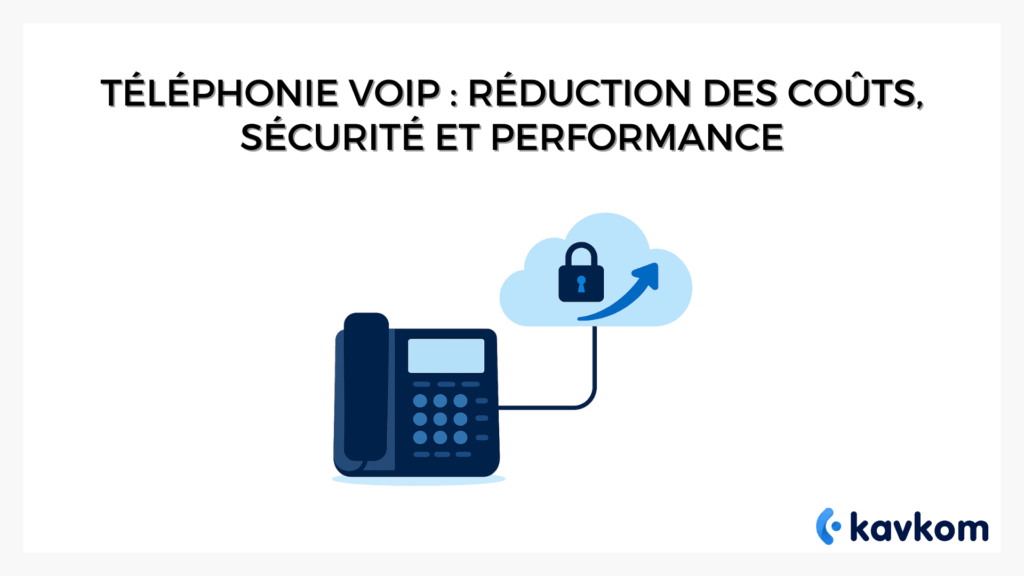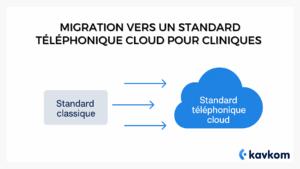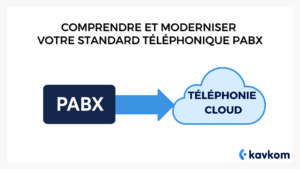In this article, you will discover how voip telephony can combine cost reduction, security and performance. You will find clear technical explanations of how the IP solutionsolution, its advantages and limitations, and the essential criteria for successful adoption in a professional environment. This comprehensive guide will give you the precise answers you need to make your decision easier.
Points to remember
- VoIP telephony replaces traditional lines with the Internet for simpler, more flexible calls.
- It reduces costs: less wiring, adjustable subscription and no heavy downtime.
- Security is ensured by flow encryption (TLS, SRTP), RGPD compliance and strict access management.
- VoIP integrates easily with business tools (CRM, ERP) and remains compatible with various terminals (softphone, IP phones).
- Its limitations do exist(a stable Internet connection is required), but these are more than offset by the gains in mobility and advanced functionality.
Introduction to VoIP telephony: definitions and fundamentals
VoIP telephony is no technological mystery reserved for engineers. Behind this acronym (Voice over IP), it simply means transmitting voice over the IP network, rather than the old PSTN network. In other words, your conversations are carried over the Internet instead of over traditional copper cables.
In practical terms, a VoIP or IP phone simply uses the same connection that already powers your e-mail and work tools. VoIP technology is based on standard protocols such as SIP, which enable you to make or receive telephone calls from a computer, DECT handset or even a smartphone. As a result, you no longer need a complex hardware switchboard (PBX); everything is done in an IPBX hosted in the cloud.
So, how does it all work? Imagine a simultaneous translator: your voice is broken down into small packets of data, sent over the Internet and reassembled at the other end, in real time. Whether you’re using a cordless phone, a softphone or a simple browser, the principle remains the same.
The difference with a classic line is obvious: more flexibility, more mobility, and an openness to modern communication solutions. Where a fixed-line telephone limited teams to a single office, the all-IP model now makes it possible to manage calls over the Internet from anywhere, with the same quality as at the company’s head office.
In a nutshell:
- VoIP = your voice over the Internet.
- An IP phone = a telephone connected to the network.
- SIP = the universal language that lets devices talk to each other.
- Cloud PBX = the telephone switchboard hosted in the cloud.
The economic and operational benefits of VoIP telephony
According to ARCEP, migration to IP telephony is now part of a general trend to simplify and modernize corporate communications. In other words, VoIP is no longer a marginal option, but a logical choice for those who want to reconcile cost savings and agility.
The promise of a VoIP telephony solution is simple: less fixed costs, more freedom. Where conventional telephony requires cabinets full of cables and analog sets, VoIP eliminates almost all cabling and hardware costs. You no longer pay for the infrastructure, only thesubscription and actual usage.
On a day-to-day basis, this flexibility translates into complete mobility. An agent can make and receive calls from his or her office, or from home by telecommutingor even from their smartphone. Everything is managed like a conventional telephone, but without the limitations of the physical office.
The benefits don’t stop at savings. Modern
This cloud approach adapts to real needs. A start-up can start with a few lines, then increase its capacity without changing hardware. Conversely, a large
Why VoIP is a game-changer:
- Immediate reduction in fixed costs (no more unnecessary wiring).
- Flexible subscription, actual billing.
- Mobility: employees work wherever they want.
- Advanced features available at no extra cost.
- Scalable, business-driven enterprise telephony .
Security and call quality: challenges and solutions for VoIP telephony
In its report entitled State of the threat targeting the telecommunications sector, that communications infrastructures are now prime targets for cyber attacks, making the security of communications and the availability of services more critical than ever.
A legitimate concern: when voice travels over the Internet, it becomes a data stream like any other, exposed to the same risks.
Fortunately, VoIP telephony is not left defenseless. The SIP protocol, which drives exchanges, can be reinforced with encryption mechanisms (TLS, SRTP) to guarantee secure communications. What’s more, professional solutions respect RGPD compliance, by integrating secure hosting and access control.
Then there’s the question of call quality. We’ve all experienced those choppy conversations due to weak Wi-Fi. In reality, VoIP today delivers HD voice quality, provided you have a stable and sufficiently fast Internet connection. With broadband (or even ultra-broadband), calls are smooth and consistent. The choice of router, LAN configuration and prioritization of voice traffic on the internal telephone network are just as important as the technology itself.
Finally, operators are increasingly opting for architectures based on interoperable standards, such as the open SIP standard, to secure and enhance communications without proprietary lock-in.
What you need to know to make VoIP reliable
- Check available bandwidth (high or very high speed).
- Choose a professional router and segment the LAN.
- Encrypt voice flows with TLS/SRTP.
- Choose a solution that complies with RGPD and open standards.
Integration and compatibility: connect your existing tools and systems
Internet telephony only makes sense if it’s truly integrated into everyday life. The good news is that today’s VoIP solutions don’t live in a vacuum. They can be easily connected to your CRM, ERP and other business software via API ready to use.
In concrete terms, users can initiate a call from a CRM customer file, or display the complete history of an exchange as soon as the phone rings. The result: less copying and pasting of phone numbers, more time for… conversation.
Terminal flexibility is total. Do you work in the office? The classic IP phone is still a safe bet. On the move? A softphone installed on your computer or mobile takes over. And if you prefer dedicated hardware, brands such as Yealink, Gigaset or Snom offer VoIP-compatible models that can be configured in just a few minutes.
In short, VoIP doesn’t impose new reflexes: it adapts. And that’s what makes it such a smooth communications solution, whether you’re an SME or a large corporate telephony structure.
Limits and drawbacks to consider with VoIP telephony
There’s no miracle solution without a few safeguards. VoIP relies on a stable Internet connection: if your network weakens, your calls weaken with it. This is the first Internet connection dependency to bear in mind.
Another point: bandwidth consumption. Multiparty conference calls are fine on very high bandwidth… but on saturated ADSL, you’d better have a plan B.
The transition from the analog world also raises a few practicalities: your old landline phone or handset won’t always be compatible. In some cases, you’ll need to invest in a wireless VoIP extension with an integrated DECT base. The good news is that these models often feature a modern LCD display, far more practical than the old monochrome screens.
Finally, it all depends on your VoIP operator. Some guarantee exemplary continuity of service, others less so. In other words, before migrating, you need to check that your critical data flows are not based on an aging PSTN network, but on a solid IP infrastructure.
3 things to check before adopting VoIP
- Quality and stability of Internet connection.
- Hardware compatibility (old handsets vs. new VoIP models).
- Actual commitment level of the chosen operator.
Criteria for choosing the right VoIP solution
Choosing a VoIP telephony solution isn’t just a question of price. It’s a balance between cost, reliability and flexibility.
First criterion: the quality of telephone communications. Test the stability of the platform, call handling, and make sure that the voice remains clear even during periods of heavy network load.
The second criterion is security. SIP account access management and encryption are essential. Without them, VoIP becomes a gateway for intruders.
Third criterion: compatibility. Check that the solution works with your IP phones, SIP phones and even your business tools. Serious suppliers always publish a list of compatible SIP phones and software.
Fourth criterion: basic features. Don’t overlook the essentials:
Fifth criterion: scalability. A good solution should keep pace with the growth of your business telephony, without hidden costs or major overhauls.
Selection checklist
| Criteria | Why it’s key | What to check |
|---|---|---|
| Call quality | Comfort and reliability | Testing in real-life conditions |
| Security (SIP, encryption) | Data protection | Strong authentication |
| Compatibility | Continuity of use | List of supported hardware & software |
| Basic features | Practical | Transfer, messaging, conferencing |
| Cost and flexibility | Budgetary control | Clear subscription model |
Final tip
Before you sign up, ask for a demonstration and see for yourself what benefits the provider has to offer. Nothing beats first-hand experience to find out if VoIP fits your needs.
Putting it into practice: adopting the Kavkom solution for high-performance VoIP telephony
Switching to IP telephony doesn’t have to be a headache. With Kavkom, it’s all about simplicity: you open a phone number, configure your accesses (on computer, mobile or softphone), and you can immediately make conference calls or activate voicemail. No wiring, no long waits for a technician.
One of our major assets is flexibility. Need to cut your lines in summer or during a slump? Pro-rata billing means you can cut or adjust your access at no extra cost. A rarity among VoIP operators. And best of all: no commitment. You’re in control, all the time.
When it comes to compatibility, you have a choice: deploy softphones, or connect your own existing IP phones (Yealink, Snom, Gigaset), which are already compatible with the open SIP standard, at no extra cost and with no hardware imposed by Kavkom. Kavkom is based on an open standard, which avoids the “technological prison” effect of certain suppliers.
Teleworking becomes seamless: your teams can access all advanced functionalities from any support, with the same quality. A true continuity of communication solutions between the office and home.
Kavkom highlights
- Installation in minutes, not weeks.
- Flexible, real-time billing.
- Responsive human support (no chatbot loops).
- Compatible with your existing equipment(softphone or IP phone).
- Key features include conference calls, voicemail, supervision.
FAQ – Frequently asked questions
What is a VoIP phone and how does it work?
A VoIP phone uses IP telephony: your Internet calls go through the IP network rather than through conventional lines. In practice, VoIP allows you to transform voice into data and send it like an email.
What are the economic and operational advantages of VoIP telephony?
The advantages of telephony are clear: lower costs, greater flexibility. A VoIP telephony solution lets you make calls and organize conference calls, with tools designed for modern business telephony.
How does VoIP guarantee call quality and communication security?
Call quality depends on a good Internet connection(broadband). Thanks to the SIP protocol, exchanges are encrypted, which reinforces the security of communications.
How do you effectively integrate a VoIP solution with existing tools?
A compatible VoIP solutionintegrates easily with your CRM and ERP systems. Users can manage their customers from a single tool, with true continuity in communication solutions.
What are the potential limitations and drawbacks of VoIP telephony?
The main limitation: dependence on the Internet connection. In the event of an outage, a cordless phone or DECT base station can take over, but some still keep an eye on the PSTN network or a landline.
Conclusion
VoIP telephony has become a matter of course for businesses: simpler, more flexible, richer in telephone communications. With a single telephone number, you can centralize calls, supervision and mobility in a single VoIP telephony solution.
It’s up to you to discover what IP telephony can do for your organization.





